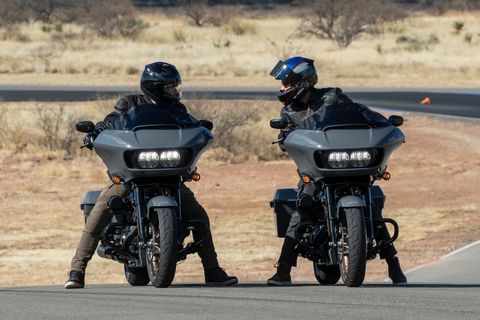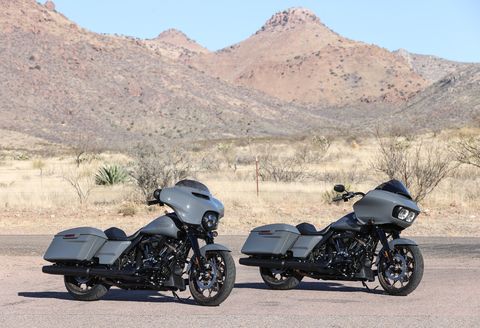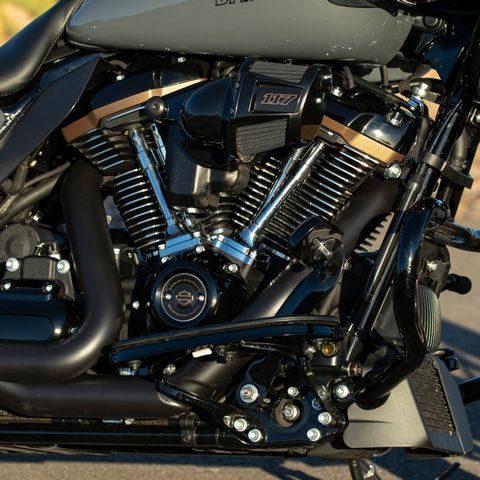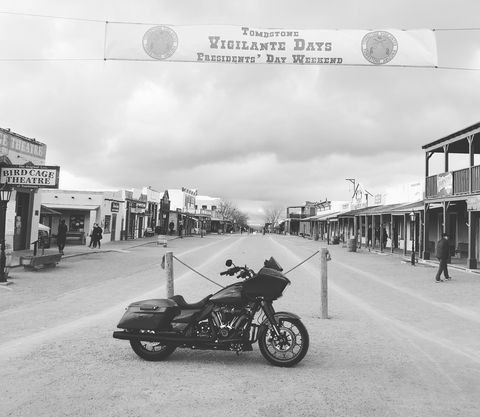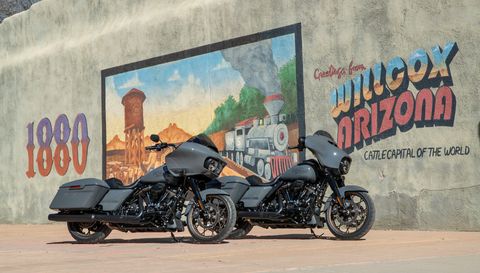Every few years a new style rolls across the landscape of the motorcycle industry like a tsunami, upending everything that came before. From crotch rockets to “American Choppers” to cafe racers, style trends are as inevitable in motorcycling as they are in music or fashion. Some leave their mark on the industry, while others fade like ripples in a pond.
The latest trend in street bikes is the performance bagger. The style incorporates the ever-popular “bagger” motorcycle (really, just a cruiser with saddlebags) modified for performance and/or agility. With its new 2022 Street Glide ST and Road Glide ST, Harley-Davidson attempts to capture the zeitgeist of this trend. These new performance baggers—effectively, souped-up versions of existing models—are available now at a dealership near you.
While not to every rider’s taste, its undeniable Harley-Davidson motorcycles have a timeless appeal and iconic panache. But will this new style have an industry-wide impact that lasts beyond the fad? We’ll see. In the meantime, Autoweek recently got the opportunity to ride the new 106-hp STs in an environment perfectly suited to show off what sets them apart: the race track.
What’s a Performance Bagger, Anyway?
Since the turn of the 21st century, the number one-selling Harley-Davidson worldwide has been the Street Glide, and it’s not even close. Far outselling the rest of the H-D model line, the popular Street Glide and its sibling Road Glide—the lynchpins of Harley’s Grand American Touring lineup—have widely been credited with saving the Motor Company’s collective bacon over the last few, lean years.
These two baggers are distinguished from one another mainly by their fairings. The Street’s single-headlight batwing fairing is mounted to its fork and turns along with the handlebar, while the Road Glide’s sleeker dual-eyed fairing is frame-mounted, staying put regardless of where the handlebar is pointed.
Same powerplant, same chassis. Their performance numbers, technical specs, and dimensions are effectively identical. Yes, aside from a few styling touches, the difference between these two popular baggers pretty much ends at their respective noses.
After more than a decade of cruiser market domination by these bikes, it was only a matter of time before owners started customizing them. Hey, that’s what the Harley-Davidson brand was built on, right? A platform for customization.
Certain decorative flourishes have (thankfully) come and gone over the last decade or so, including gaudy paint jobs, lowered rear ends, teeth-rattling subwoofers in the bags, and massive front rims that made these bikes look more like Big Wheels for grown-ups than street-worthy motorcycles. But handling on these blinged-out baggers was unwieldy, ground clearance was nonexistent, the speakers left little room for luggage—and seriously bro, no one else wants to hear your music.
Tastemakers responded. For the last several years, bike builders and stunt riders have taken a different approach to customizing these baggers by souping up their engines to give them way more horsepower and torque than your typical interstate hog will ever need. Then, they beefed up the rear suspension for more ground clearance and a deeper lean angle—and proceeded to ride the ever-lovin’ crap out of ’em. The performance bagger was born.
You’ve likely seen the videos on social media: riders on massive Harleys cruising down the freeway at impossible upright angles, front wheel pointed straight at the sky and a shower of sparks trailing behind as the rear fender scrapes along the pavement. It’s either impressive or ridiculous, depending on your POV. Both perspectives are correct.
If you’re a racing fan, though, you know performance baggers can be way more than stunt bikes. Bagger racing has exploded in popularity the last few years. The success of numerous regional bagger races led to last year’s debut of the new and exciting “King of the Baggers” series on the MotoAmerica circuit. The series is a breath of fresh air to professional motorcycle racing and a kick in the pants to watch—and one that any racing enthusiast should be enjoying as it heads into its sophomore season in 2022.
This content is imported from Giphy. You may be able to find the same content in another format, or you may be able to find more information, at their web site.
The new ST versions of Harley’s popular baggers have leaned hard into this racing aspect of the performance bagger trend, and from where we’re sitting that’s a very, very good thing. The new Street Glide ST and Road Glide ST are powered by the largest, most powerful production Harley engine you can get off the showroom floor: the monstrous Milwaukee-Eight 117-inch (1,923 cc) V-Twin.
It cranks out 127 lb-ft of torque at the rear wheel and a delicious 106 horsepower via a high-performance camshaft, high-flow Heavy Breather intake, and 2-into-1 exhaust tuned to maximize performance. (The Screamin’ Eagle 131-inch crate engine is available as an optional upgrade.) Brembo brakes, longer emulsion-style adjustable rear shocks, and 49-mm forks complete the performance package.
The Street weighs 814 pounds at the curb, while the Road Glide ST comes in at 842 pounds. Heavy? Certainly. But the hi-po, 117-inch powerplant makes these bikes far more rideable than Harley’s sluggish pre-2016 baggers with their stock 103-inch Twin Cam V-twin. The longer rear shocks increased the travel on both Glides nearly 40% over stock, but bumped the seat height less than an inch, from 26.1 ins. to an extremely mountable 26.7 ins.
Cosmetic enhancements and creature comforts include dark paint schemes in either black or grey, and Harley’s proprietary (and undeniably excellent) Boom! Box GTS infotainment system that features navigation and Bluetooth connectivity accessible via an 8-inch, full-color touchscreen mounted in the dash.
Floorboards are standard, and electronic cruise control will give your throttle wrist a break on the highway. LED headlamps light up the road, and Harley’s Smart Security System with its hands-free fob means no one else can start or steal your bike.
What separates these two baggers from the standard Street and Road Glides? The more powerful engine offers a full 10 cubic inches of displacement over stock and 16 more lb-ft of torque, while the longer rear suspension provides extra ground clearance and a deeper lean angle. Aside from the cosmetic flourishes, that’s the only real difference between these STs and their stock counterparts.
No matter which aspect of these new bikes you appreciate the most, one thing about Harley’s new performance baggers is undeniable: If you want a Street or Road Glide ST, it’s gonna cost you. The MSRP for each is $29,999.
On Track, on Road
We met these new Harleys at Inde Motorsports Ranch in Willcox, Arizona. On hand to help us learn how to ride these beasts was the 2021 King of the Baggers champion himself, Kyle Wyman, as well as his racing brothers Cody and Travis. Before we trailed the Wyman brothers for a few instructional laps, we were coached in basic track skills by renowned AMA racer Nick Ienatsch, who’s also one of the most respected riding instructors in the game.
Learning about suspension load, expanding the tire contact patch, and the benefits of trail braking was super insightful, even to a longtime rider. I’ve practiced these riding skills in rudimentary forms on the street, but watching Nick and the Wyman brothers explain the how and the why of these riding concepts, and demonstrate the way racers use them to attack a racetrack, was really enlightening.
If you’ve wondered how professional motorcycle racers can hang off the side of a bike and get low enough in a turn to scrape a knee puck on the pavement without falling over, it’s all about using throttle and brake at the same time, to gain both speed and stability through corners at almost any angle. Nick’s Yamaha Champions Riding School can show you how to dance that delicate tango.
Simultaneous braking and throttle might sound counter-intuitive—indeed, some might argue it’s why the brake lever and throttle are on the same hand grip—and it goes against what many of us were taught as beginner riders.
But Nick maintains a lot of us simply learned (and are still learning) to ride incorrectly, and a few laps under his tutelage will convince you it’s a safer, more effective way of motorcycling whether you’re aboard a sport bike on the track, or on a bagger in the twisties. Check out the online version of his riding course, ChampU, for lessons you can put into practice next time you ride.
The Inde road course is notoriously challenging, but the STs handled it with aplomb. Power is plentiful at both the bottom and top end of the throttle, and the inch or two of expanded lean angle means the ST’s floorboards scrape only on the sharpest of curves.
On an auspiciously cold, clear morning in the desert, I followed Kyle Wyman around the 21-turn, 2.75-mile track several times, getting the feel for the big performance bagger as I put Nick’s track lessons into practice: using the brake and throttle together, shifting my weight accordingly and, most importantly, continuing to brake through each turn until my bike was pointed in the direction I wanted it to go.
These STs are by far the best braking Harleys I’ve ever had the pleasure of stopping. The linked Brembo system makes it nearly impossible to apply too much momentum-jarring grab to either wheel, so braking is remarkably responsive and incredibly smooth. It’s an ideal system for the track, lending these heavy, powerful baggers the stability they need to take road-course turns with decreasing radii at speeds as low as 10 mph.
After a dozen or so laps we were attacking those same curves at several times that pace, and Kyle cut me loose to tear up the track on my own. I was just getting into a groove when the rain came, putting an abrupt and disappointing end to my session.
After lunch the skies cleared so we took the STs out on the highway, heading on a 100-mile run down to the legendary Old West town of Tombstone. Just as we enjoyed a round of warm-up coffees, the skies opened up again—first with hail and ultimately a light snowfall. It all lasted about an hour. We raced back to Inde shivering and damp, but the fairings kept most of the moisture off everything but our legs. The Street Glide ST in particular handled both country two-laners and freeway stretches handily.
A Bagger for a New Generation?
Recent data shows the age of the average motorcyclist continues to rise into the 21st century. Moreover, young consumers in all industries continue to demonstrate less brand loyalty than ever. Will these new performance baggers be the Harley-Davidsons that draw younger motorcycle consumers back to the iconic brand and into dealerships? Or will beginning riders and buyers continue to trend toward used and imported bikes?
Considering the recent popularity of stunting and racing performance baggers, the opportunity was there for Harley to grasp that generation of motorcyclists raised on the X-Games and riders like Carey Hart and Travis Pastrana. Unfortunately, it seems H-D might have repeated the same flub as when it debuted its electric LiveWire motorcycle in 2020: Regardless of the quality of the motorcycle, a $30,000 price tag is likely to scare away any potential young buyer.
Because stylistic fads come and go, leaning into the performance and racing aspect of performance baggers was a smart approach on Harley-Davidson’s part. But there’s a slew of creature comforts on these bikes that could’ve, should’ve been optional add-ons, which would have increased their affordability measurably.
A full-color, infotainment touchscreen is a lovely perk for those who want it. However, most motorcyclists who want to talk on the phone or listen to music or get directions while riding—and bear in mind, there are many who do not—are already connected via smartphone, a RAM Mount, and an in-helmet comms unit. Or, they already own a bagger or touring machine that has a stereo, if not an infotainment system.
I’d like to see Harley replace the floorboards with footpegs, and ditch the chunky touring fairings, along with their infotainment units and dual speakers, for a style more in line with the racing circuits and what’s called “club style”—tighter, lighter, and more compact fairings with simple gauging. The bronzed flourishes adorning the engine are beautiful, but by no means essential.
Oh, and lose the pricey electronic cruise control. Buyers who want touring amenities could simply order all those bells and whistles from the dealer and have their bikes delivered fully dressed and ready for the interstate. Or Harley could easily build out an “Ultra” or “Limited” touring package for these STs, and charge top dollar for them off the lot.
Those relatively simple tweaks could almost certainly drop the entry-level cost of both of these Harleys to a far more approachable price point, somewhere in the low to mid $20s. That alone would attract a younger buyer—especially the one whose taste for performance baggers leans more toward club style.
Fact is, some performance bagger enthusiasts and journalists I spoke with feel the trend is already fading among tastemakers and customizers on the coasts. Worse, the simple fact that an OEM has brought a trend-following bike to market is often enough to stop any fad dead in its tracks.
Most agreed Harley will likely sell a bunch of these new Street and Road Glide STs over the next two or three years. But considering the price tag and “fad factor,” most of those buyers will likely be Harley-Davidson brand loyalists who already own a pre-2016 Glide and can afford to trade up.
Bottom line? Harley Street and Road Glide owners who desire more power and performance from their baggers, especially those made before 2016 when the Milwaukee-Eight engine was introduced, should upgrade now. The new Street and Road Glide STs are the most agile, powerful baggers H-D has ever introduced to its showrooms, and they more than live up to their “performance” promise. Here’s hoping for a version that someone who doesn’t already own a $30,000 motorcycle can afford.
Wheelies, as always, are optional.
GEAR:
HELMET: Harley-Davidson/Arai FXRG Defiant-X
COMMS: Cardo PackTalk Bold JBL Headset
JACKET: Harley-Davidson FXRG Gratify
GLOVES: Racer Multitop 2 Waterproof
PANTS: UglyBros MotorPool
BOOTS: Cortech Vice Waterproof Riding Shoes
This content is created and maintained by a third party, and imported onto this page to help users provide their email addresses. You may be able to find more information about this and similar content at piano.io

